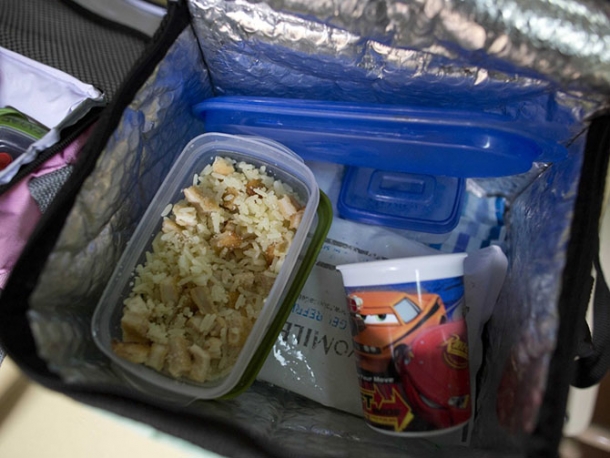
Proper nutrition for schoolchildren menu for the week. Schoolchildren's diet. Healthy breakfasts for schoolchildren
It just so happens that this is the third post about food lately, I promise, I’ll stop there for now. But I just could not get past school lunches. Already the heart ached at the milk, covered with frozen oily foam, cold eggs with a blue yolk, slimy scrambled eggs and gelatinous porridge, which flops into a plate like a blam and does not cause appetite.
From July 1 next year, a number of innovations will come into force in relation to the new catering in preschool education, general education and children's social institutions. For example, children will be offered free drinking water in schools and kindergartens. If tap water is not quality, the body will have to take care of delivering the water.
In addition, the staff of the institution will have to find out if there are children with allergies. They will have to cook food without allergens. All children's educational institutions will not be able to use products that currently only allow nutritional supplements which are prohibited in schools.
Am I the only one full of such memories of school canteens? Or were children more fortunate in other countries? The project was prepared by a group of photographers from the Associated Press organization.
What do people eat in different countries Ah, everyone already knows that. But everyone knows that school is a special world. And here everything is not the same as in ordinary life. But how exactly? We have collected a whole archive of photos.
Educational and educational institutions with canteens will be able to purchase fruits and vegetables from individual farmers. The description of the new order also states that in addition to schools, there may be gardens, livestock, so that children can participate in the cultivation of the fruits and vegetables they eat, and thus better understand how food comes and how much it needs to put its work.
It all depends on the products that are used for catering. According to the Deputy Minister, the Ministry of Health receives many complaints about the taste of food, but due to the quality of the food, it is recommended to contact the school management, which is directly responsible for the menu.
Lambersard, France. She is France! Slice of grain bread, salad with celery, orange, sweet donut, rice with salmon, ratatouille. Royal table!

Buenos Aires, Argentina. The children eat Milanesa, chicken fried in eggs and breadcrumbs. And rice for a side dish.

Bamako, Mali. Fried donuts are prepared for children, sometimes they are given rice and meat. But most of the schoolchildren believe that all this is tasteless, and eat at home.
The cheapest dinner is the chef in the school cafeteria. Usually when the diet is organized by the winners, we have the biggest complaints. If the school has a cook, lunch can cost about 2.5 litas. Klishonis asked if it is possible to eat healthy food for 4 litas.
According to him, lunch in Scandinavian schools is also very cheap - they cost only 1 euro. From January 1, meals in schools and kindergartens are produced in accordance with changes in the description of the catering organization. Amendments to the description supplement the list of products prohibited for baby food, the permitted amount of sugar and salt, the use of hydrogenated fats for cooking, the permitted amount of sugar and salt. We are talking about the director of the Utena School kindergarten"Varpelis" by Rita Lekerauskienė and Dita Lina Bulkienė about the nutritional habits of schoolchildren and pupils, culinary innovations, the depth of nutrition and the depth of children.
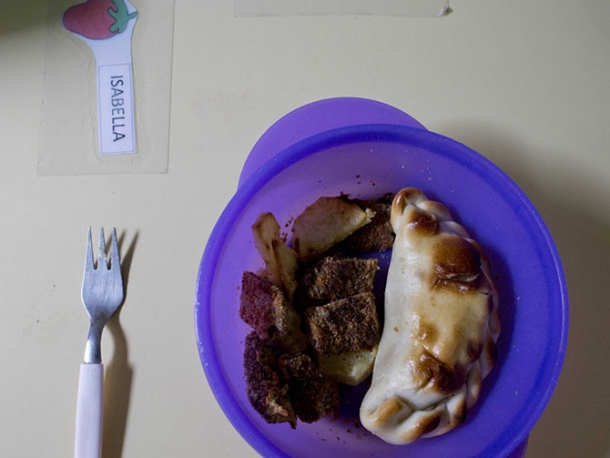
Buenos Aires, Argentina. Another school offers potatoes and pancakes with the same Milanesa.

Havana, Cuba. Children eat rice, chicken nuggets, taro root, pea soup. Bananas for dessert Orange juice. I think this is a great breakfast!
Less - sugar, fat-free fat. Utena-kindergarten "Varpelis" daily feeds up to 200 children and employees. Most students eat their own meals - the free lunch break has plummeted this year as the municipality tightened rules. Out of 96 children elementary school 11 children free. Almost a hundred kindergarten parents choose one of two options: a child in kindergarten eats three or two meals a day. In this kindergarten, as in other kindergartens in Utena, there is no fixed amount of money for food - the principle that the child should receive required amount protein, carbohydrates and other nutrients have long been observed.
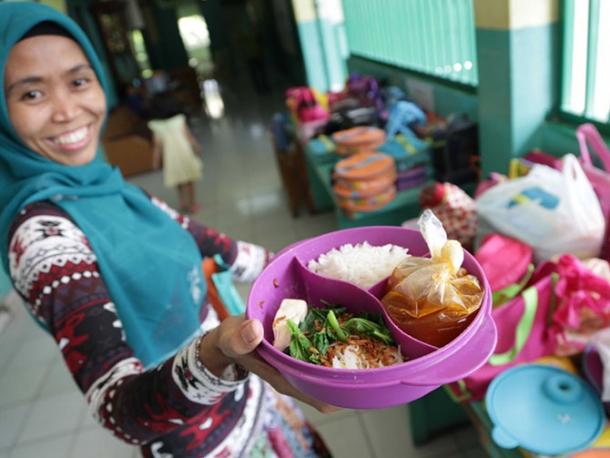
Jakarta, Indonesia. Here, too, healthy food is held in high esteem. Rice, meatball soup, tofu ( bean curd) and vegetables.
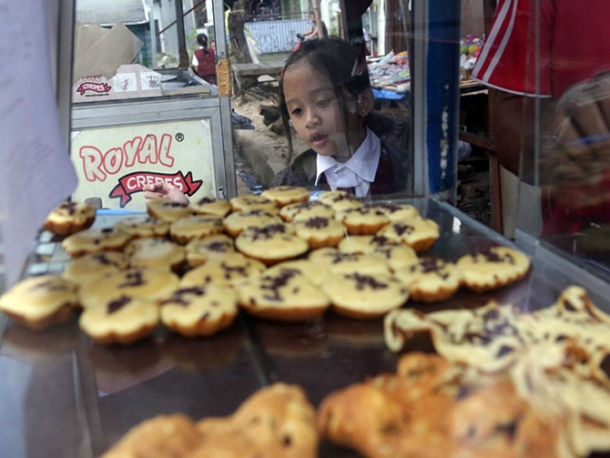
And schoolchildren can buy pies or pancakes with seasoning for 35 kopecks.

Jammu, India. Children carry lunch from home. The composition includes pita bread, stewed turnip and mango.
The fixed amount is only for the free dinner - it costs 1.14 euros. The cost of a daily meal for kids varies - it depends on the price of the groceries you buy, and the kindergarten fee is different every month. Children are served according to approved meals: one for Kindergarten, one for beginners. The meaning of the menu is to match the dishes so that the child receives all the necessary materials for the week and in good portions. Parents, bringing the child to the nursery, always know what their children will eat for breakfast, lunch or dinner - menus are published in groups.
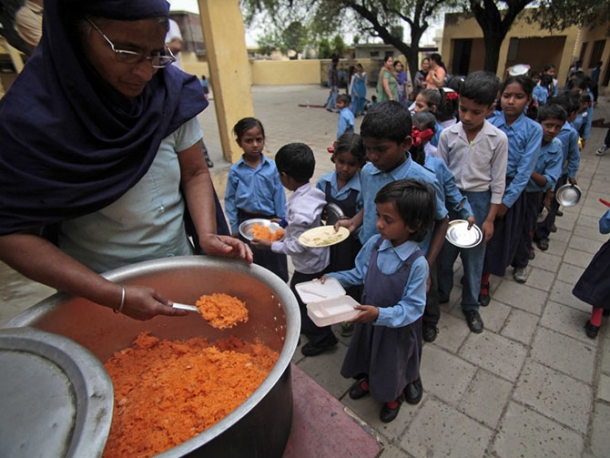
Jammu, India. Schoolchildren are also given free rice with sugar. Behind him, the students stand in line and eat it along with what they took from home.
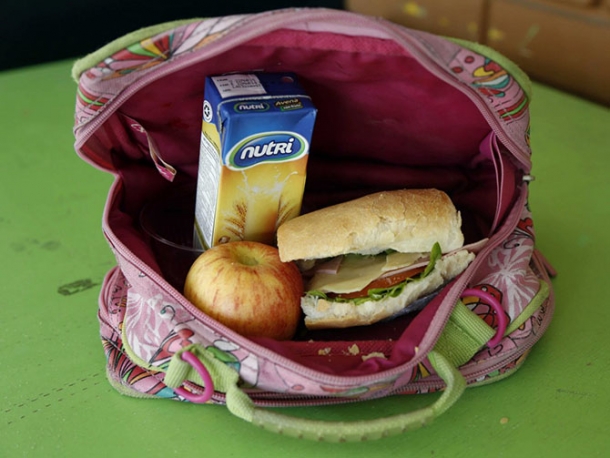
Quito, Ecuador. They offer lunch with ham, cheese, tomato and salad. Drink - from cereals. Apple.
From January first courses are produced in accordance with changes in the description of the catering organization. We studied the new requirements with Dita and came to the conclusion: our menus meet them. It looks like a big innovation, but we and our children have eaten so much, says director Rita Lekauskainen. Nutritionist Lina Bulkienė describes the novelty: A list of products prohibited for baby food is added to the list of amendments to the description. Nutritionist says cheese has never had a problem with food - after all, children do not buy potato chips in kindergarten, and the sugar content in tea never exceeds the norm - tea can contain no more than 5 g of sugar in 100 ml of water.
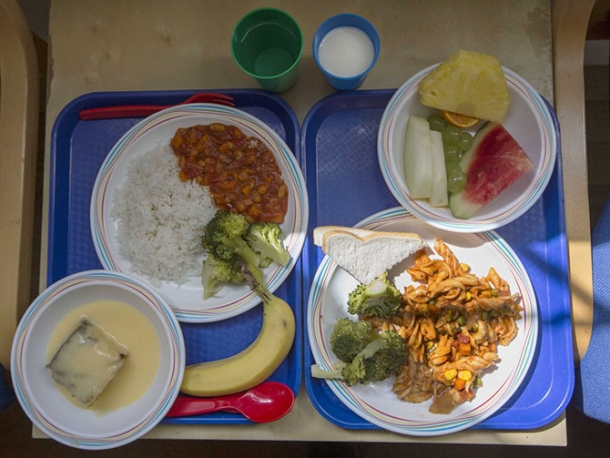
In London, children can choose from meals prepared in the school cafeteria. For example, here is one of the standard school lunch rations. Right: Broccoli omelette, bread, fresh fruits. Left: broccoli rice, chilli sauce, sponge cake with custard, banana.

Barcelona, Spain. Cult healthy eating instilled in childhood. Children are given vegetable cream soup, fried veal, salad, bread, oranges, bananas. Incredibly delicious! Some people don't eat like that even as adults.
In kindergarten - without sugar or with the minimum amount Sahara. In other words, add a maximum of 1 teaspoon of sugar to a standard 200g cup or tea glass. But what bad cooking class do we sometimes drink to our kids? Coca-Cola is just a sugar bomb. After drinking, you can add 8 teaspoons of sugar to tea, says the director. Another prohibition is the use of hydrogenated fats in food production. Hydrogenated fat that we left a long time ago. We don't buy margarine using utensils, we only use oil and butter, the diet says.
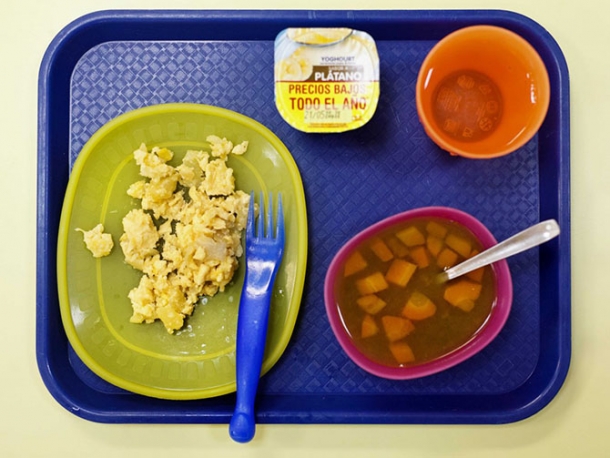
Madrid, Spain. Children eat omelets vegetable soup, drink fruit yoghurts and more water.

Nablus, Palestine. Children are given sandwiches with them: pita bread, which is stuffed with ground dried thyme, sesame seeds, salted and watered olive oil. The mixture is called zaatar.
According to the specialist, hydrogenated fats mainly consist of fast food, margarine and confectionery. Hydrogenated fat is a raw material for the production of margarine and cooking oils. Vegetable oil heats up to 240 degrees. These chemical reactions do not occur naturally, they are created by humans. Hydrogenated fat is cheaper, it slows down animal fat, but healthy nutritionists will name a lot of threats to health, - the woman explains.
For many years, Rita Lekerauskienė, who has worked for the director, says he has only just started working to prepare the children's favorite meals. However, having realized the secrets of cooking, healthy eating, the attitude changed. "And the composition of the products you buy, the recommended menus and recipes - everything passes through our prism," says the director. Therefore, there are no bakers in Varpel anymore. First the kids bought a lot of cloves, then they tore them apart - let them buy them until they completely refuse to bake them.

Paris, France. Real gourmet food. Stewed pike with green beans and champignons.

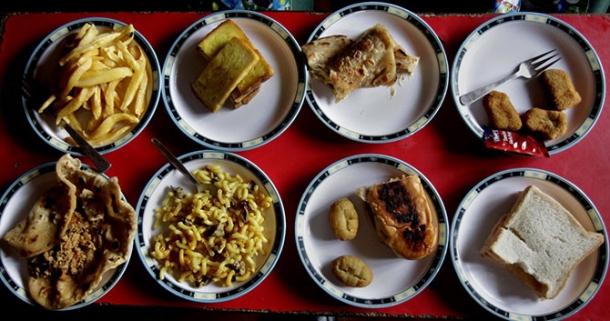
Rawalpindi, Pakistan. The kids are trying to buy fast food. There are no lunches as such, so the school principal asks parents to cook for children healthy lunches and watches how they eat right in the classroom. Eggs for lunch chicken meatballs, vegetables, rice, noodles, hamburger lamb or beef. Not all at once, but selectively.
And it's not about making chefs easier on their cookies. The director mentions several reasons. First, don't chew the cakes. Secondly, warm cookies are not digested. Thirdly, children "clog" the stomach and do not want dinner. "Buns are not best product for children, although children love them,” the director calculates.
But sausages have disappeared from the menu. “We make everything fresh,” says the director. Raspberries were in the food of children and, by all means, were a rare guest - they were used only in scrambled eggs. And the smell of pancakes, like in children, sometimes shines - then the children rejoice: "Today it smells like pancakes." The dentist laughs: "If we only look at the wishes of the children, we will keep pancakes on a daily basis." Kindergartens often eat porridge for breakfast. Children's diet is still a plate, but it is rarely baked because it is barely digestible.
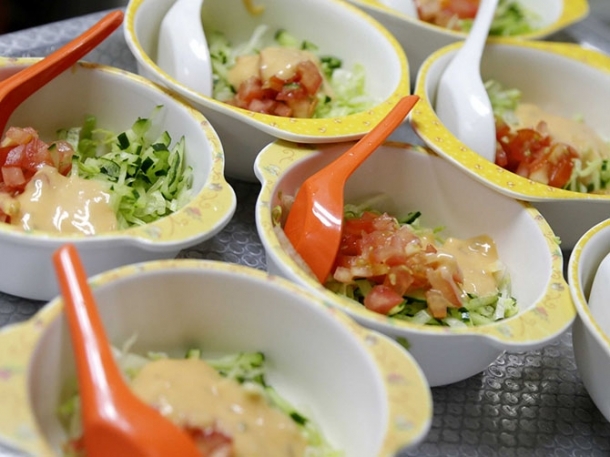
Singapore. In school canteens, a healthy lifestyle has recently been actively promoted, so now every day children are given salads from fresh vegetables and greens, and also give bread, fruits, juices, barley and beans.

Seattle, USA. Here, children are given fried bread with cheese, corn salad, fresh carrots, applesauce or canned pears, skim milk.
Sea scallops - only boiled potatoes to facilitate digestion. Children don't like vegetable stew. Vegetables such as "isolated": if cucumber - only cucumber, if tomato - only tomato. Even one porcini asked one mother to feed the following: separate carrots, separate peas, separate potatoes. Next to the bandage - if the child wants, he will fit, - says the director. The director considers: maybe you want to refuse a white sandwich? But it is difficult to change something in the mix, it has many components.
Doubts arose because of the mayonnaise, which is decorated with mushrooms. According to the diet, the kindergarten cannot read food labels, and the composition of mayonnaise is also being specified - it is forbidden to eat children in food. “We don’t eat much in mayonnaise in the children’s diet - half mixed with sour cream, we only add carrot salad and white mussel,” says the nutritionist. Future plans include whole wheat flour.

The second breakfast option is a salad with chicken, which is made from nitrate-free hams, whole grain bread, fresh red pepper, peas, beans or corn. Coriander is suggested as a condiment.
My interest in the school lunch menu of the world arose after meeting the blog of a 9-year-old schoolgirl from Scotland Martha Payne which has already become popular all over the world, especially among schoolchildren. Back in April 2012, Marta started a school food blog, NeverSeconds, where she regularly posts photos of her lunches and talks about how healthy they are. After some time, the school principal decided to ban the girl from taking pictures in the canteen, but there was no stopping her: children from all over the world began to send her photos of their school lunches, Martha received more than 10 million views, Scottish parents began to protest against harmful chocolate milk in the school diet , and British newspapers dubbed Martha "the new Jamie Oliver." Now the schoolgirl participates in the Mary's Meal charity program and saves starving children in Malawi, and a book about her and her blog has become a bestseller in England.
It is currently recommended that parents prefer to use whole grain flour in baby food. Coarse grinding flour is much healthier and healthier than regular flour white flour obtained by removing the germ and hide from fat. Vitamins and trace elements are removed along with the grain. We will try to buy. Only whole grain flour and pasta are expensive which means the food has to be appreciated and on the other hand it's doubtful if the kids will eat - the pancakes will be dark. But we're not going to make all the dishes from full grains - parents won't know, says the director.
And it all started with the fact that Martha took a camera from her father and began to photograph her school lunches. Moreover, she introduced a 10-point rating scale, in the comments to the dishes she described what her portioned lunch consisted of, the taste of the ingredients, whether a hair was found, and even how many pieces would need to be taken from a fork or spoon to eat the entire dish.
Employees eat from the same bank. Employees of the school kindergarten "Varpelis" can have lunch in the educational institution itself. And food does nothing for them individually. We eat the same pot in childhood - the same size, the same composition. Only to the south we pay 85%. more expensive than children - the language of employees is done differently than children, food is provided by the director. According to the nutritionist, food products calculated in grams. A computer program is used for it - a menu is added, the number of people who eat, and the program shows the need for products.
1. Scotland.
The first photo was of a slice of pizza and a potato meatball, along with sweet corn and cookies for dessert.
Martha wrote: “The benefit of this blog is that now dad understands why I am hungry when I come home. She also complained about poor satiety: “I'm a growing child and I need to be concentrated during the day, but I can't do it on one meatball. Do any of you think he can?"
On the west coast of Scotland, where Martha lives, standards for school meals vary. Martha, with the permission of her teachers, took pictures of her £2 school lunches and gave them a grade. Says Marta: “When I started posting these photos, I thought only my family and friends would see them, so I was very surprised that so many people are worried about school meals. When I posted pictures of tea on my blog, the number of views exceeded 1 million!
The news of a student being banned from posting photos of her own meals sparked criticism from bloggers and Martha Payne's father. Petitions were even sent to the school demanding that the ban on photographing lunches in the school cafeteria be lifted. This extraordinary decision of the local authorities was also widely covered by local newspapers.
Hot dog, corn, croquette and dessert.
Local authorities did not take into account the strength and speed of the reaction social networks. Just a couple of days after the ban was introduced, Argyle and Bute County Superintendent Roddy McQuish acknowledged the mistake and ordered the ban lifted. “I changed my mind,” he admitted. “Censorship has no place in our district.”
Authorities have lifted a controversial ruling that banned a nine-year-old student from posting photos of her school lunches on her blog. The Telegraph newspaper writes about this with reference to a high-ranking representative of the district administration.
Potato, pineapple, carrot sticks, pepper, ham and dessert.
By the way, Martha's mother works as a medical practitioner. The girl herself began to write because she was interested in journalism. The girl's father admitted to the press: “I'm shocked. Never thought to attract so much interest."
Since then, Marta has been quietly leading a blog so beloved by many.
Shepherd's pie with minced meat in gravy, fresh cabbage salad, cucumber, cake and melon.
Chicken noodle soup, rice, corn, vegetable spring rolls, milk chocolate shake.
One of Martha's favorite meals: Chicken curry, rice, broccoli, shortbread and ice cream.
Martha with actor Benedict Cumberbatch.
Now consider school lunches from other countries.
2. Finland.
Vegetarian sausage soup Rye bread with cheese, cucumber and milk.
Braised sauerkraut with lingonberry jam; salad of cabbage, cucumber and grapes; milk.
Salad, curry chicken, served with beans and carrots, pudding, milk.
Here we need a little digression. In Finnish schools, there is no rigid menu - the children themselves choose from several dishes what they want to eat. The task of the teachers is to convince the children that 50 percent of the dinner should be salads and other healthy foods. Since school in Finland starts at the age of 5, the understanding of the “right” food is formed quite early.
Vegetable soup with potatoes, carrots, onions, broccoli and zucchini, rye bread, cheese and tomato.
Another small digression. In Finland the school day is usually short, sometimes up to 12 noon. Therefore, lunch is not so voluminous :)
Fried fish with pesto sauce; potato; salad with watermelon, cucumber and peach; milk.
3. USA.
Spokane, Washington. Cheese, lettuce, turkey, kiwi and cauliflower
.
Chicago, Illinois. Spaghetti bolognese, fruits and vegetables.
Austin, Texas. Turkey salad, mashed potatoes, peach pie, iced tea.
Spaghetti, salad, lollipops, chocolate drink.
Atlanta, Georgia. Jewish school. The cost is $5.5. Beef tacos, rice, crispy noodles, hummus, sunflower seeds, chicken soup-noodles.
San Diego. Chili with bread, salad bar, pineapples and milk.
4. Great Britain.
Canteens have a vegetarian option on the menu (there are many Hindus in schools in the United Kingdom). Usually this peas, baked potato, cake with custard. Option: instead of potatoes, you can have cauliflower with cheese.
For ordinary students, as a rule, - sausage, hamburger or chicken nuggets, salad, apples.
Village of the West Midlands, England. Whole grain bread with lettuce and ham; apple and grapes; a cup of vegetables (tomatoes, radishes, sweet peppers);
5. Japan.
Sendai. Fish, seaweed, rice with tofu and egg, soup, salad with sesame dressing.
Yokohama. Pickled daikon radish, sour plum, konnyaku jelly (umm ... such a chewy extract from plants, as I understand it), green carrots, beans, garlic, white fish, vegetables and eggs boiled in soy glaze. In general, one burda :)))
Fried fish, dried seaweed, tomatoes, miso soup with potatoes, rice, milk.
Kagoshima. Rice, chicken soup, fried flying fish, steamed vegetables, milk. The cost is $2.9.
Fukushima.
Nagano.
6. China.
Nanning, Guangxi. Soup, pork with rice. The cost is 8 yuan or 0.80 euros.
Shanghai, German school. Sausage with French fries, carrot salad, a piece of cake.
7. Taiwan.
8. Germany.
Frankfurt am Main. Rye-wheat bread with butter, clementine, pomegranate seeds, homemade Turkish meatballs, candies. Cost: about 1.50€ (£1.20).
Rye-wheat bread with butter and gouda bunny cheese, cherry tomatoes and grape-cheese-sticks. Cost: about 1.30€ (£1.04).
Hamm, a city in western Germany. There is no canteen, only a cafe.
9. Israel.
Falafel, pita pieces, yoghurt with cucumber sauce, herbs.
10. Czech.
Vegetable soup with semolina, beef with garlic, served with spinach and potato dumplings, orange.
Vegetable soup with dumplings; fish stew With mashed potatoes, peas and tomatoes.
Vegetable soup, Mexican-style rice with beans and corn, canned pineapple and peaches, water with lemon.
Beef soup with noodles and carrots; fried steak with mashed potatoes; beets, celery salad, hot fruit drink.
11. Brazil.
Meat with rice green salad, pudding, strawberry juice.
Fish, potatoes, tomatoes and bell pepper, rice, beans, zucchini. The cost is around R$10.00 (£3.16, $5).
12. South Korea.
Seoul. Rice, Kimchi soup, pork, fried dried seaweed, tofu with soy sauce, sweet rice cake. The cost is 2500 won or $2.5.
White rice, lettuce, shrimp, fried ketchup patties, kimchi and soup with pork bones and potatoes. The cost is the same, $2.5.
Fried rice with dried seaweed; soy paste stewed with green pumpkin, mushrooms and potatoes; radish kimchi, corn, cottage cheese casserole and grapes.
13.Spain.
Barcelona. Fried fish with tomatoes and lettuce, bread, apple.
Barcelona.
Zucchini cream soup with fried bread; sea scallop with lettuce.
catalan soup, chicken breast grilled with french fries.
Paella (rice with carrots, zucchini and pork loin), meatballs with potatoes.
14.Singapore.
Meat, rice, lettuce, melon.
15. India.
Chennai. Lentil soup, pumpkin salad (local variety), rice, cottage cheese, and semolina dessert (kesari), kefir.
Bangalore, Canadian International School. Fish nuggets, spring rolls, lettuce, noodles, melons, figs.
16. France.
Chicken nuggets with French fries and broccoli, bread, pasta with vegetables, salad and a slice of cake.
17. Sweden.
Vegetarian option: potatoes, coleslaw and beans, crackers and lingonberry juice.
18.Cuba.
Beans, rice, fried banana, a piece of fish.
19. Australia.
Pancakes with smoked salmon and cream cheese; grape tomatoes, strawberries. The cost is $5.
Melbourne. Chicken nuggets, banana and chips.
20. UAE.
Croissant stuffed with Middle Eastern Za "atar spice mix, cucumber, carrot, strawberry, orange, fruit juice.
21.Ukraine.
Soup, a few pieces of sausage, pasta, pickle, bread, tea.
22. Estonia.
Tallinn. Red cabbage and beetroot salad, boiled rice, baked zucchini with cheese and tomato, cocoa. The cost is 2.3 euros.
HOW ARE US?
23.Russia.
Moscow has recently undergone a reform of the system school meals. The kitchens where breakfasts and lunches were prepared were closed. Food is supplied by large factories that provide the so-called "flight meals". Dishes are delivered in the morning. In school canteens, they are only warmed up.
Moscow. The usual lunch in the capital's school: soup, cutlet with pasta, some vegetables and juice for baby food.
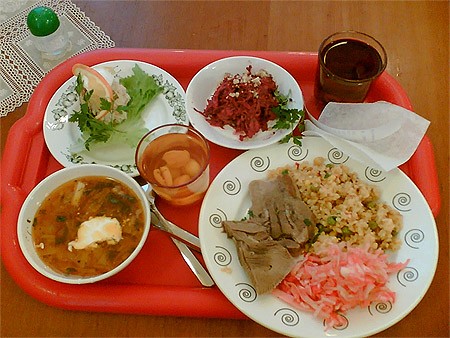
Kemerovo.
St. Petersburg. Some schools in the city have food from the Concord factory. The cost of lunch is 32 rubles.
Of course, there are no uniform dinners in countries. In private schools, the food is better, in public schools it is often worse. There are regions where meals are not provided at all - children bring food with them in lunch boxes. But in general, it is possible to imagine the peculiarities of lunches and the logic of doctors and cooks (in many countries, the school menu is coordinated with the sanitary services, in Russia, by the way, too).
lunch boxes .
But examples of lunches in lunch boxes that are prepared at home say a lot about the parents themselves and about their attitude to food and health, both their own and their child :))
England, Chester. Bean burger with chili sauce and cheese, shortbread.
USA. Chicken sandwich, salad, canned pineapple. The cost is $2.
USA. Dardanelles. Lake. Camp. Ramen noodles with green beans and almonds, Hawaiian mix, hot fruit juice, apple cider or hot chocolate of your choice. Cost: $2.32.
Georgia. Carrots, mixed fruits, peanut butter, bread and water.
Australia, Jakarta. Mini French toast with cream cheese and smoked salmon, fruit, carrots and yogurt.
Ireland. Croissant, apple, cucumber, croutons.
Ireland. Russian cuisine :)) Dumplings, cucumber, drinks.
Japan.
Canada. Fruits (blueberries, strawberries, raspberries), carrot sticks, peas, boiled egg and kefir.
France, Burgundy. Sandwich, carrot, apple, cheddar crackers and donut.
Sri Lanka. Rice in milk - Kiribath ( a traditional dish), fruit.
West Africa, Nigeria, Lagos. Jollof rice with chicken and beef. I'm surprised that in Africa they feed like that :). It's the same for lunch at school.
Of all the presented menus, I boldly choose the Czech Republic, Spain, Sweden, Finland and South Korea :))
And once again I am convinced that in the USA it is simply necessary to change the entire food system in schools, and in the bud. No wonder why there are so many fat people in the USA! All school years - continuous synthetics, chemistry and calories.
And how is it in your school, does the menu, prices suit you?